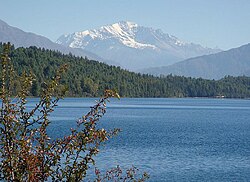
The Rara Lake (Nepali: रारा ताल) is the greatest and most profound new water lake in the Nepal Himalayas. It is the primary element of the Rara National Park, situated in the Jumla and Mugu Districts.[1] In September 2007, the lake was proclaimed a Ramsar site, covering 1,583 ha (6.11 sq mi) including the encompassing wetland.[2]Rara Lake lies at a height of 2,990 m (9,810 ft) above ocean level, has a water surface of 10.8 km2 (4.2 sq mi), a greatest profundity of 167 m (548 ft), is 5.1 km (3.2 mi) long and 2.7 km (1.7 mi) wide. It channels into the Mugu Karnali River through the Nijar River.[3] Its water quality is portrayed by high pH, conductivity and aggregate hardness. It was accounted for to be marginally dirtied and was named oligotrophic in limnological terms. It is dirtied because of squanders created amid celebrations by going by local people and tourists.[4]Summer is very charming however winter is frosty. The best going to time to the lake is September/October and April to May. From December to March, the temperatures go low underneath the point of solidification, and substantial snowfall happen up to one meter, obstructing the path to the lake. April to June is warm in this region.[5]
Storm season, which in this area happens between the times of July to October, is short. The normal precipitation amid the ten-year time frame 1994–2003 was 800 mm. The surface temperature of the lake was observed to be 7.5 °C to 7.6 °C and was noticeable beneath 14 m to 15 m.[4]Rara Lake, being encompassed by Rara National Park, has remarkable botanical and faunal significance with uncommon and defenseless species. The recreation center was set up in 1976 to safeguard the magnificence of the lake and shield it from sedimentation and unfavorable human exercises. The Park verdure comprises of 1074 species, of which 16 are endemic to Nepal; the fauna incorporates 51 types of warm blooded creatures and 214 types of birds.[6]
The lake holds three endemic fish species Nepalese snowtrout (Schizothorax macrophthalmus), (S. nepalensis) and the Rara snowtrout (S. raraensis) and one endemic frog, Rara Lake frog (Nanorana rarica). Winter guest water feathered creatures, for example, gadwall (Anas strepera), mallard (Anas platyrhynchos), northern shoveler (Anas clypeata), basic greenish blue (Anas crecca), tufted duck (Aythya fuligula), regular brilliant eye (Bucephala clangula), basic merganser (Mergus merganser), basic coot (Fulica atra), and singular kill (Gallinago solitaria) live and rest at this lake[4]The principle control of the general population living around the territory is agribusiness. Individuals additionally raise goats and concentrate restorative herbs and offer them for their living. Thakur society is overwhelming in the group. Thakur Baba's Temple is arranged in the southeast corner of the lake. Nearby individuals trust that the god Thakur shot a bolt to open the section of the lake diminishing the harm caused by flooding.[3]
Issues: Due to over-brushing and poo, the national stop protection officers are confronting a test to save the lake. Nearby individuals are discovered cutting timber wood and fuel wood, which is an issue for preservation of Rara. Likewise amid celebrations guests and nearby individuals deliver a ton of wastage causing water pollution.[3]Rara lake has been a prominent goal with a harsh course in Western Nepal for trekkers. The looks of culture and view in transit is very not the same as whatever remains of Nepal. Arranged in high elevation, you can discover the lake encompassed by Rara National Park with pine, spruce and juniper woods. The perspective of snow-topped Himalayan pinnacles upgrade the fascination of trekkers. The trek starts with flight to Jumla (over a hour flight from Kathmandu) or from closer Nepalgunj. Coming the mountain way and a few towns one can achieve the bank of Rara lake.[7]
A travel author depicts his trek to Rara:
Albeit more trampled than previously, the street to Rara Lake is still with no of the agreeable administrations accessible along more well known trails. Strategically it is not a simple trek; it is difficult to get to and from, and it is an authoritative test, requiring educated aides and watchmen to tote the two weeks of material that will keep you warm, dry and bolstered. It is likewise intense on the bones, including a few 11,000-foot passes. Be that as it may, once you defeat the obstructions, the prizes are army: barely any different trekkers, unique normal magnificence, "untouched" towns, joyful calm.… [8]
Rara Lake as portrayed by GORP originator Bill Greer: "a shining blue gem set in a ring of cold peaks".[8]
Trekkers are prescribed to bring their own medical aid pack because of the absence of wellbeing administrations around the range. Since there are no settlement offices they may require assistance from a travel office. Trekkers should act naturally adequate as the offices are not adequate.[5]
Rara Lake as portrayed by Mark Drett:
"Since the interim of 10 years, I went by once more. Before 10 years, we expected to walk 19 days to arrive yet that has been decreased to 10 hours of rock street and 4 hours of walk. Not expected but rather extraordinary change. When you arrive, you will get the reward for 4 hour long walk."
Rara can be the following real place for visitors to visit. Amid 1997–1998 the quantity of vacationers going by to this place was observed to be 560, yet in 2007 it diminished to 87 people. Rara Festival was directed by the Nepal Tourism Board in mid 2007 to advance local and worldwide visit.[3]Air is the main method of transportation for the sightseers going by the Rara Lake. Rara Lake is served by Talcha Airport, which is 4 km east of the lake. Nepal Airlines and Tara Air work flights to Rara from Nepalgunj.
No comments:
Post a Comment